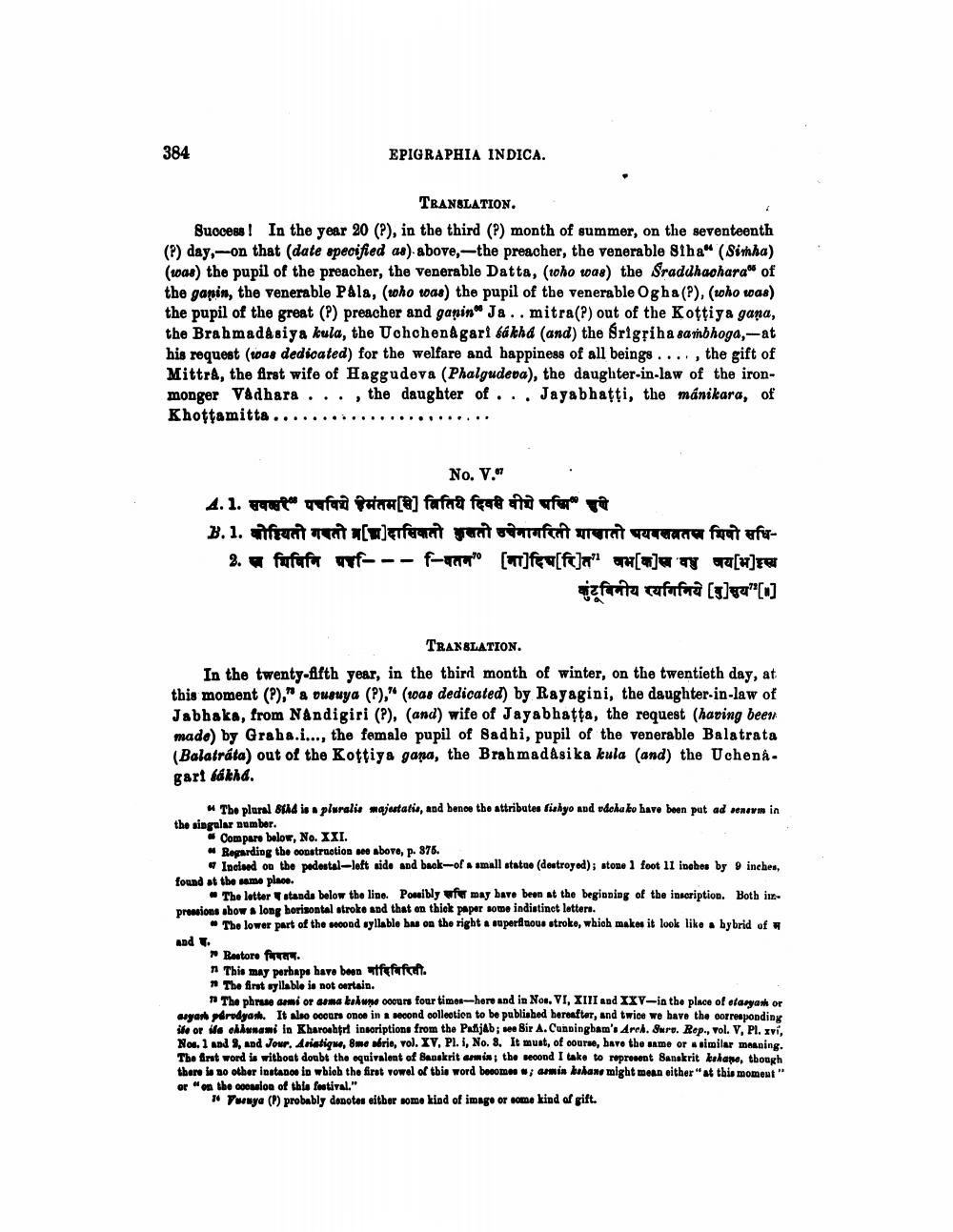________________
384
TRANSLATION.
Success! In the year 20 (?), in the third (?) month of summer, on the seventeenth (?) day, on that (date specified as) above,-the preacher, the venerable 81ha" (Simba) (was) the pupil of the preacher, the venerable Datta, (who was) the Sraddhachara" of the ganin, the venerable Påla, (who was) the pupil of the venerable Ogha (?), (who was) the pupil of the great (?) preacher and ganin" Ja.. mitra (P) out of the Kottiya gana, the Brahmadasiya kula, the Uchehenagar! kid (and) the Srigriha sandhoga,-at his request (was dedicated) for the welfare and happiness of all beings...., the gift of Mittra, the first wife of Haggudeva (Phalgudeva), the daughter-in-law of the ironmonger Vådhara . . ., the daughter of... Jayabhatti, the mánikara, of Khottamitta..
EPIGRAPHIA INDICA.
No. V.
4. 1. सवत्सर" पचविशे हेमंतम[से] द्वितिये दिवसे वीथे अस्मि" हुये
2.1. funt n't n{w)erfiant yerit vänrefoût zrurat wawunner firût ufe- f - वतन" [ना] दिप[रि]त" बभ [क] स्व वधु जय [भ]हस्य izfefta cafafaâ (3)TO
2.
fufafar af
TRANSLATION.
In the twenty-fifth year, in the third month of winter, on the twentieth day, at this moment (?)," a vusuya (?)," (was dedicated) by Rayagini, the daughter-in-law of Jabhaka, from Nandigiri (?), (and) wife of Jayabhatta, the request (having been made) by Graha.i..., the female pupil of Sadhi, pupil of the venerable Balatrata (Balatráta) out of the Kottiya gana, the Brahmadasika kula (and) the Uchenâgari lakhd.
the singular number.
The plural Sind is a pluralis majestatis, and hence the attributes fishyo and váchako have been put ad sensum in Compare below, No. XXI.
Regarding the construction see above, p. 375.
Incised on the pedestal-left side and back-of a small statue (destroyed); stone 1 foot 11 inches by 9 inches, found at the same place.
The letter stands below the line. Possibly fer may have been at the beginning of the inscription. Both inpressions show a long horizontal stroke and that on thick paper some indistinct letters.
The lower part of the second syllable has on the right a superfluous stroke, which makes it look like a hybrid of
and .
70 Restore fa.
This may perhaps have been affefefeft.
The first syllable is not certain.
The phrase aemi or asma kehune occurs four times-here and in Nos. VI, XIII and XXV-in the place of etasyam or aryah parodyam. It also occurs once in a second collection to be published hereafter, and twice we have the corresponding ife or ife chhunami in Kharoshtri inscriptions from the Pafijab; see Bir A. Cunningham's Arch. Surv. Rep., vol. V, Pl. xvi, Nos. 1 and 2, and Jour, Asiatique, 8me série, vol. IV, Pl. i, No. 8. It must, of course, have the same or a similar meaning. The first word is without doubt the equivalent of Sanskrit armis; the second I take to represent Sanskrit kehane, though there is no other instance in which the first vowel of this word becomes ; asmin kahane might mean either" at this moment" or "on the occasion of this festival."
Tusnya (P) probably denotes either some kind of image or some kind of gift.




